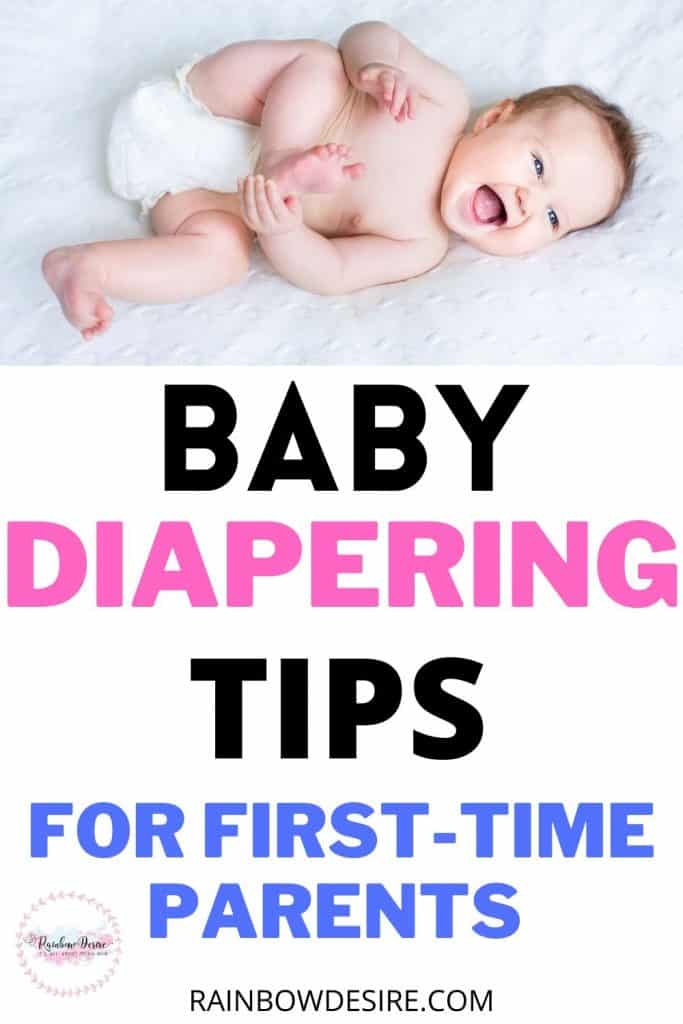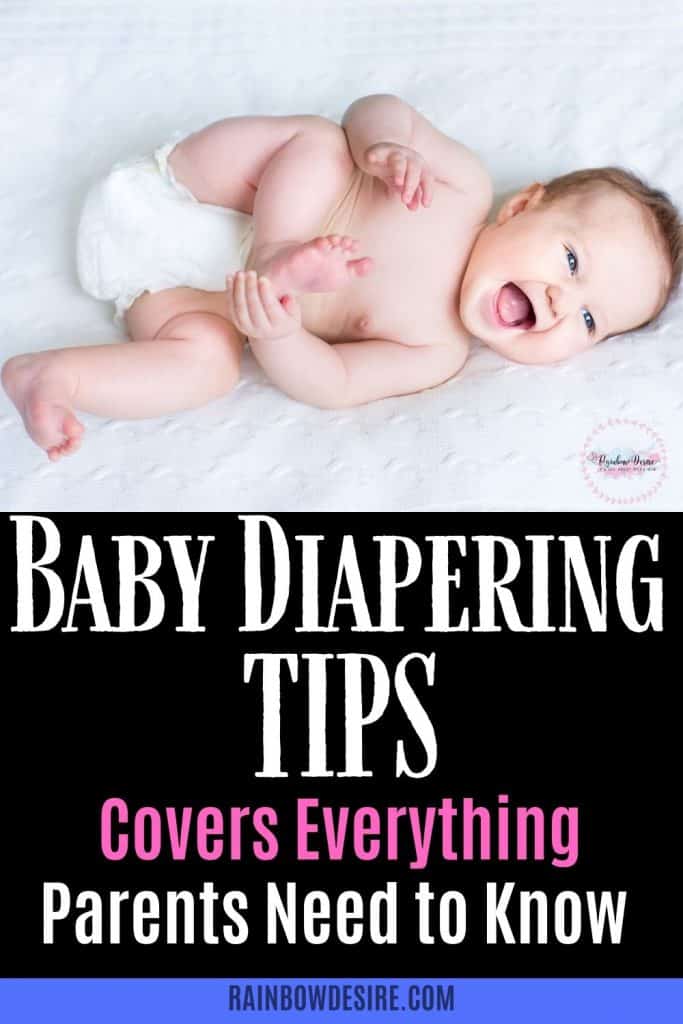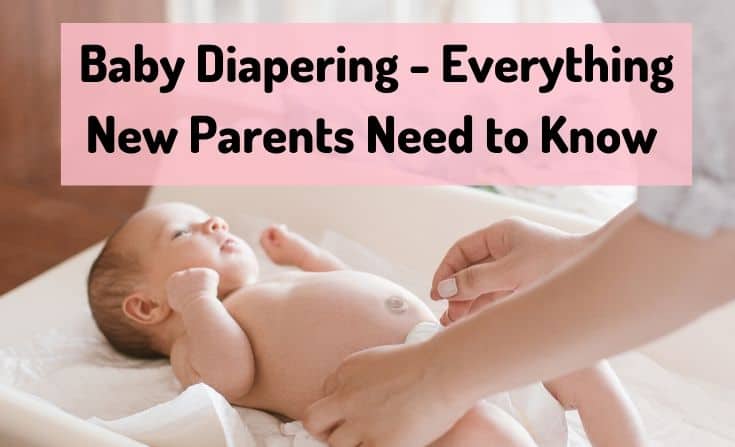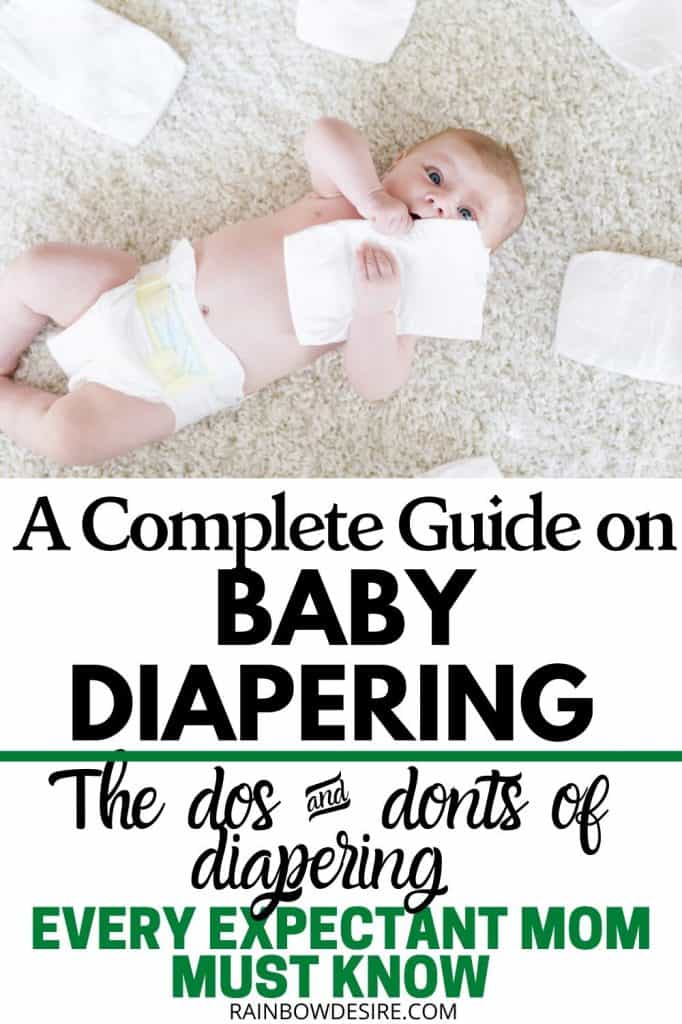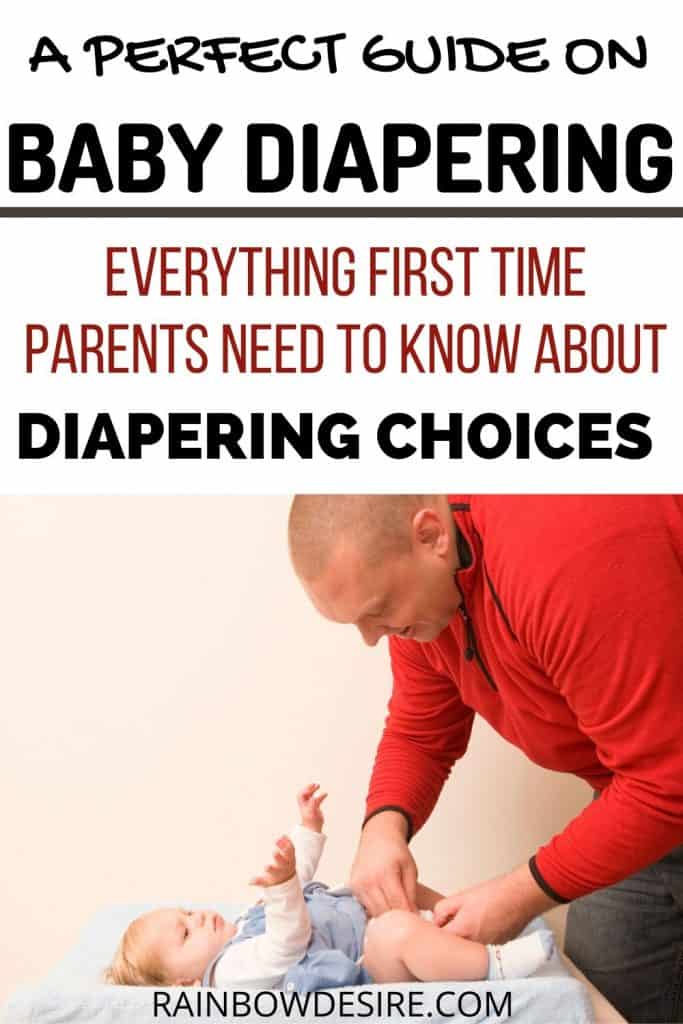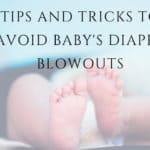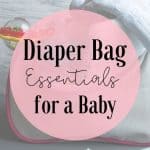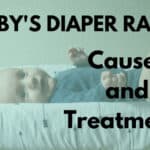Diapering is an unavoidable part of parenthood. Your kids cannot go diaper-less until they are 2 to 3 years old. On average parents change 3000 diapers during their first year alone, and that makes roughly about 8 to 12 diapers a day.
Baby diapering Guide – Everything new parents need to know
As a matter of fact, not everyone is a pro in diapering. There are potential risks of pee sprays, blowouts and a lot more battle going on for parents. The art of diapering involves doing it, faster, less mess, and getting better every time parents change baby diapers.
This post may contain affiliate links. Please read our disclaimer for more information.
Cloth versus disposable Diapers
There are two ways for diapering, one is a disposable way and the other one is a washable way, meaning cloth diapering. Before you decide which one to choose, as a new parent you need to consider both options.
Disposable diapers
Disposable diapers are very absorbent and feel dry for the baby until they get over soaked in pee. Most of the good diaper brands take about 8 to 12 hours on average with one diaper taking in pee only.
However, newborns tend to change at least 8 to 12 diapers a day as they are peeing and pooping more frequently.
Also, Using disposable diapers make babies more vulnerable to diaper rashes believed by cloth diaper advocates.
However, no matter what may be the pros and cons are of cloth and disposable diapers, the biggest advantage of using disposable diapers is it definitely adds convenience to parenthood.
Cloth diapers
Cloth diapers are made with soft cotton and believed to be more comfortable than disposable ones. However, they are not very absorbent and needs diaper change quite frequently. They have an outer layer of stay dry cover which does not let everything getting wet outside.
The main advantage for moms using cloth diaper for their babies is, it is COST SAVING only if you are washing it by yourself at home. If you are getting the washing done from diaper service then it is going to cost for detergents and water. That being said, it is not as cost-effective if you have to pay for washing services.
Certainly using a cloth diaper is an environment-friendly choice and less convenient for the most part.
That being said as a parent, you know what is best for your child.
PreemieMomTips blog has a detailed guide on cloth diapering.
What Diaper brand to choose
Choosing a good brand of diapers is very important. Generally, some more absorbant diapers tend to be more expensive, and the cheaper ones happen to be less absorbent. Either way, It costs you pretty much the same meaning, more cheap diaper approximately equal to less expensive diapers.
And one more thing is about the baby’s sensitive skin. Keeping the baby’s skin in mind is an important aspect of choosing diapers (Cloth Vs Disposable).
Pee detector is another factor you have to choose for the newborn phase. Diapers that have pee detectors are perfect for the first 3 months when you have to monitor baby’s wet diapers. Just FYI pee detector turns the line blue when your baby urinates.
Diaper sizing
Choose the right size for your baby. As babies grow they get to pee and poop more so eventually you would need more absorbency.
If you notice you are having frequent diaper leaks and blowouts, it’s time to go a size up. Bigger size means more absorbency.
For some babies, the diaper size and weight limit run small, do not be afraid to try one size up if your baby feels tighter in the tummy area.
Avoid diapering on the umbilical cord until it comes off. Many newborn diaper brands have umbilical cord safety curve on top, you can still fold the diaper from the top just to be safe with the umbilical cord.
The most challenging part of parenthood is preventing blowouts because there are going to be zillion until your baby starts walking. Read some tricks to prevent blowouts that new parents must know.
Buying diapers
As a first-time parent when you buy diapers do not stockpile small sizes too much. To get an idea, your baby is going to grow out of newborn size and size 1 within 6 to 8 weeks.
Pampers Swaddlers are the best for size 0 and size 1 diaper with urine detector.
Pampers cruisers are the best so far in absorbancy, fitting and coverage once your baby moves to size 2 and up.
Get the small size in lesser quantity
By the end of two months, most babies fit well in size 2. therefore, Do not buy too many small sizes in the beginning.
Divide the number of diapers with a cost of so you will know how much it going to cost you per diaper and how many you going to need in a day. Do your math and find deals.
Every baby is different, some may have a chubby physique and some are lean so fitting and absorbency both matters.
Find and Cut coupons
You can get coupons deals, use them to cut diapers costs.
Think big and buy in advance – if you find good deals, think about buying diapers in advance. Moreover, you may able to find deals online on Amazon for a good price. Other stores like Target offer a gift card on the purchase of baby essentials for a certain amount.
Watch out for the fake diapers that are low on quality as well as absorbancy.
Wipes for newborns
Wipes are used for cleaning poop after every soiled diaper change. Diapers and wipes are frequently bought together. However, wipes can still be harsh for a baby’s soft skin.
For sensitive skin, the best you can do is after wiping baby’s bottom, use a wet soft washcloth or you can wash baby bum every time you change a diaper. Make sure you dry the baby’s bottom thoroughly with a clean towel. A poop residue may trigger skin rash, in that case, washing with water is the best remedy.
Ideally, keeping skin sensitivity in mind choose wipes that are fragrance-free as fragrant wipes may trigger eczema related issues in babies. I highly recommend using fragrance-free Huggies wipes. They are soft and cleans well.
Baby wipes are not normally flushable wipes, so do not flush them in the toilet unless you are using flushable wipes.
In order to be cost-effective in terms of buying wipes, you may prefer washing to minimize the overuse of wipes.
Wipe warmers -why you don’t need it
Wipe warmers keep wipes warm when the temperature is cold and wipes feel cold on the baby’s skin. Your baby is going to adjust with wipes temperature fairly quickly even if you do not use wipe warmers.
Tip: do not try to waste your money on warmers.
Tips on Changing diapers
Changing a diaper is a technique new mom and dad need to follow.
- First things first, decide, where you want to change the diaper. It should preferably be a changing table with changing pad.
- Keep diapers, wipes, diaper disposing sacks, diaper pail, diaper rash cream at an arm’s reach.
- In case of accidents, an extra outfit, a towel, an extra help of your partner (if he is around).
- You need to have multiple locations in your home for diaper changing.
- Keep in mind, most babies tend to pee as soon as they are exposed to air. Cover baby boy’s penis with a paper towel when you open baby diaper. You will learn the technique once you change a couple of diapers for your newborn.
- Put a fresh diaper under baby bottom before opening the wet or soiled diaper.
- Make sure you have a picture side on the front and tabs side on the back.
- Lift her legs up and wipe off the bottom. You can put wipes in the dirty diaper and fold it. Make sure the baby’s bottom is clean and it is not going to soil the fresh diaper.
- Once you make sure the baby’s bottom is clean, put the soiled diaper in a disposing sack and put it in the trash can.
- Close the clean diaper by sticking tabs on the front side.
- Make sure it is snuggled well on the baby’s thighs and belly. A loose or low diaper would lead to early, messy and undesirable content to escape from the diaper.
Bed liners, underpads, crib mattress pads, chux, these can help you save your home from pee and poop.
A word on the boys’ Diaper change
boys tend to spray during a diaper change. Be cautious when you have a boy at hand. Leave him open for a lesser time, be quick in your task and once you are about to close, point his penis downwards to avoid unnecessary urine sneaking out.
A word on the girls’ Diaper change
On the contrary, girls tend to have areas where poop is hidden. Well, to ensure a gentle cleaning, do not be harsh on the inner areas of the lady part as it could cause undue irritation. It is not necessary to wipe a white discharge between the folds of labia.
However, this is to remind you, just to avoid Urinary tract infections, you have to make sure you wipe from front to back.
Moreover, a healthy way could be a little wash down with fresh water to ensure cleaning.
Diaper changing safety consideration
- Never leave your baby unattended
- Avoid changing table falls by strapping your baby securely
- Beware of talcum powder. Do not use baby talcum powders on diaper areas as they are a risk to lungs if inhaled. However, if you still want you can use TALC free.
- Keep plastic bags, safety pins or any harmful object out of baby’s reach
Facts about Strange diaper objects
- Crystal-like particles are formed due to over soak in diapers. Changing frequently can stop them from appearing.
- Very rarely you may notice a Colored secretion in a diaper. Always discuss with your doctor if something concerns you in any way.
Ways to dispose of diapers
Disposing diapers can be tricky. If you have a sensitive nose you may want to get specially designed odor eliminator diaper pails. Although it won’t smell outside still the odor gets worse inside.
Many parents prefer using diaper pails and for that, you need diaper pails refills.
Just a reminder – Anything similar to the diaper pail and diaper genie can be super smelly and for that reason, I would never use that. Those who may use it and recommend may have a better way to do it.
For both of my kids, I was disposing of diapers in a regular lid trash cans and manage to trash them out twice or thrice a week. I use diaper disposing sacks for soiled diapers every time I dispose them of. Also, You may not need to dispose of wet diapers in the sack.
Here are the things I would recommend for disposing of diapers.
Medium size trash can with lid
Trash Can Deodorizers for odor elimination
Diaper rashes
Skin irritation on the diaper area is called diaper rash.
Babies could get rashes due to a number of factors but generally, it is hard to find a reason in their newborn period. The most significant reason is, contact with pee or poop can sometimes be enough to cause skin irritation.
In some cases, a yeast called Candida Albicans is responsible for causing considerable redness and irritation. Sometimes this yeast finds its way to the inside of an infant’s mouth causing thrush.
Diaper rash may get worsen due to pee or poop, hot weather, and long hours without getting changed.
How you can Treat a diaper rash
Frequently changing wet or dirty diapers and keep the area clean and dry minimize rashes significantly.
Minimizing anything that triggers rash is all you have to do, as the use of detergents, soap, diaper brands, and wipes anything can cause diaper rash. Meanwhile. changing any of them may help.
Additionally, the use of zinc oxide, ointments or petroleum jelly may help.
For severe rash, always discuss with a doctor about possible treatment. Your pediatrics may prescribe steroids or antifungal cream to treat diaper rashes.
Remedies for treating rashes
Using just a bit of baby powder (talc free) to keep area dry and avoid rashes.
Mix organic mustard oil mixed with water with equal proportions. Apply on a clean area before putting on the diaper. This is tried and tested and works 99.99% of the time to treat rashes.
Applying breastmilk is also known to be one of the most effective remedies for treating rashes.
Apply corn starch mixed with water is an effective remedy for treating rashes.
Read more
Why babies get diaper rashes and how to treat a rash effectively.
Swimming Diapers and Training Diapers
For swimming, your baby cannot wear a regular diaper as it is going to soak up water and finally burst into crystal-like particles and that is not recommended for public Pool settings anyway.
For babies and toddlers that are not toilet trained, you need to get swimming diapers. They are not going to soak pee while in water, whereas the purpose is to contain poop so it doesn’t get into the water.
For toilet training, toddlers need training diapers that are easy to pull down and up and save your home from accidents.
Diaper blowout Blocker
Newborns ruin their onesies A LOT due to poop explosions. There is a solution to protect your baby’s new outfits from getting poop stains using blowout blocker diaper extensions. They are woven, handmade, absorbent pads with a velcro-like strip that allows them to stick to ANY diaper and be reused over and over again.
Read more
Tips and tricks to prevent diaper blowouts for babies.
5 Tips to Prevent Diaper leaks at night.
